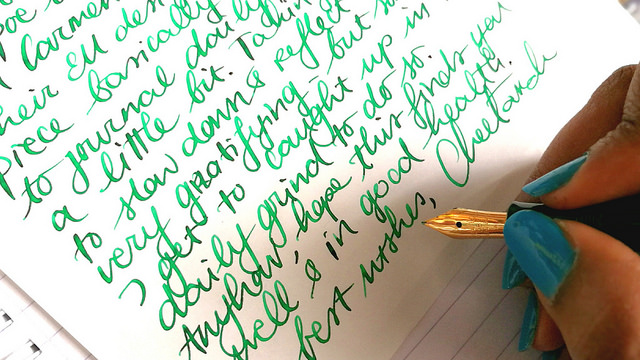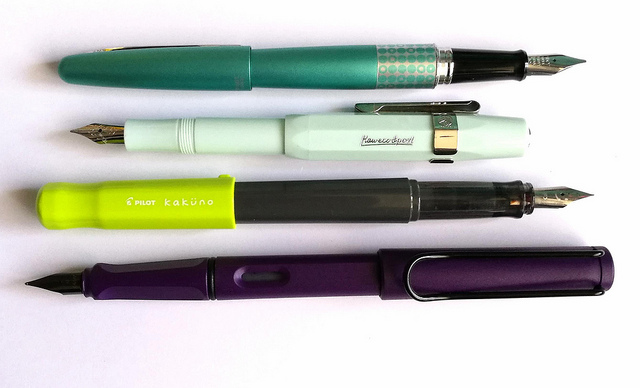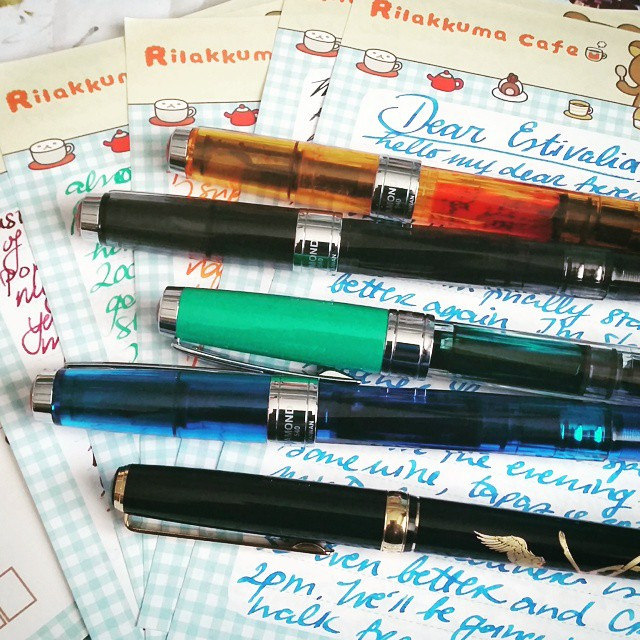Writing with Fountain Pens
This is the first (of hopefully many!) guest posts from our Netherlands Ambassador, MissThundercat. Enjoy!
From left to right: TWSBI Diamond 540 smoke, TWSBI VAC 700 Amber, Visconti Opera Elements Air, TWSBI Diamond 580 green, Omas Ogiva Alba LE Green, Pelikan M620 Athens, TWISBI Diamond 540 blue, Sheaffer No Nonsense Demo smoke, Omas Arte Italiana Vision Liquid Green and Edison Nouveau Premiere LE 2014 Caribbean Sea.
If you follow my Instagram or blog, you probably have noticed that I am an avid fountain pen collector and use them regularly. My love for these pens started when I first learned how to write with them in elementary school. And I still write with them on a daily basis. I thought it would be fun to tell you all the basics of writing with fountain pens and give you a few tips if you wanted to start up writing with them too.
Close up shot of the nib on my Pelikan M805 Vibrant blue.
With fountain pens it’s all about the nib! You have round nibs that have a round tipping and variates with a line width of extra fine to double broads and even oblique’s. And then you have stub or italic nibs which have a flat tip with which you can create lovely line variation in the down and cross strokes (usually these nibs are used for calligraphy). When starting off it’s advised to begin with a fine or medium round nib to see what suits your handwriting before starting off big like a triple broad nib.
For example, my handwriting has bigger rounded letters and I like writing with at least a medium, or even better, a broad or a stub. My husband has really small writing and often writes in small caps so he prefers using an extra fine nib to make his writing look legible. To help you on your way, Jetpens has a great blog post on choosing the right fountain pen nib. It’s a great resource and explains the various nib sizes, functions, and comparisons with brands worldwide.
Pen: Pelikan M250 with an older flexible nib. Ink: Akkerman Bezuidenwoud Groen, written on Tomoe River paper. A tip: when you want to write on blank paper, put a notebook with lined paper underneath as a guide sheet for straight writing.
In the blogpost, they also talk about pens that are beginner friendly (and won’t break the bank). I started my writing with a Pelikan school pen and a Lamy Safari. Other fun beginner pens in my opinion are the Pilot Kaküno, the Kaweco Sport, and the Pilot Metropolitan. The Lamy Safari (and Al-star) also has easy interchangeable nib options, and they come in fun colors and styles.
Top to bottom: Pilot Metropolitan (or MR), Kaweco sport skyline mint, Pilot Kaküno and the Lamy Safari (limited edition Dark Lilac)
What I like most about fountain pens is the fact that there is an array of ink available to use! Ink comes in cartridges, but you can also get a converter and fill from bottled ink. A number of companies, like Goulet pens, Anderson pens (US), Pure Pens (UK) and Apelboompennen (NL), also sell vials with ink samples so you can try out some fun colors before you decide on getting a whole bottle.
Fountain pen ink swabs on Maruman word cards.
In a future blog post I will talk about the various inks that are available, and how you can do a lot more than just write with them. But hopefully this will inspire you to pick up a fountain pen, ink it up, and start writing.
Once you get the feel of it, I hope you will join me in the Fountain Pen pal: summer edition 2016 swap. BetsyPreston hosted many of these swaps before and graciously gave me permission to host one this time around. The deadline to sign up is July 14th and you have to send your letter by July 31st. The theme is summer and you have to write at least 4 A5 pages (front) on the theme. It can be either your current summer vacation plans, your fave summer ever, memories of a fun summer you had as a child, or your thoughts on summer in general… feel free to be as creative with the theme as you can be. Just take your fountain pen, some fun stationery and write away!











